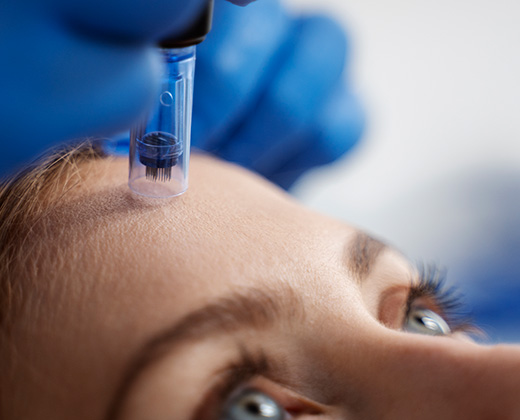What is microneedling?
Microneedling is a minimally invasive procedure for your skin. Your healthcare provider uses thin needles to make tiny holes in the top layer of your skin. The damage helps stimulate your skin’s healing process, so it produces more collagen and elastin. These proteins keep your skin firm and smooth.
Who gets microneedling?
Microneedling has cosmetic and medical uses. You might consider microneedling if you’re concerned about:
- Enlarged pores.
- Fine lines or wrinkles.
- Loose or crepey (thin and wrinkled) skin.
- Mild scars, especially those from acne or burns.
- Skin discoloration or uneven skin tone.
- Stretch marks.
The procedure can also help people who have medical conditions such as:
Alopecia areata (hair loss due to an autoimmune disease).
Who shouldn’t have microneedling?
Talk to your healthcare provider before getting microneedling if you have:
Acne or are taking medication for acne.
Blood disorders or are on anticoagulants (drugs that prevent blood clots).
Cancer and are receiving chemotherapy or radiation therapy.
Frequent skin rashes (contact dermatitis) or cold sores.
Keloidal tendency (your skin forms hard, raised scars).
Moles, freckles, skin tags or other growths that change in size or shape or bleed.
Skin conditions such as eczema or psoriasis.
Day of Treatment
Make sure to arrive with clean and hydrated skin with no facial products applied. Healthy skin will respond better and help provide optimum results. Make sure to update your physician on any medical updates.
Most microneedling treatments are done with a topical anesthetic agent to reduce the pricking sensation or discomfort. The treated area will be cleaned with an antiseptic cleanser and alcohol.
Microneedling Post Care
Below are the general day-by-day microneedling aftercare steps and healing stages.
First 24 Hours
After your microneedling treatment, immediately apply hyaluronic acid to nourish the skin. This will help stimulate collagen production as the channels for absorption close rapidly.
This can be applied every three hours for the first 24 hours. Continue twice a day for the first week to keep the skin moisturized. This is the only product applied to your skin for the first 24 hours!
Bathing is discouraged immediately after unless bleeding has occurred. Wash the treated skin with lukewarm water four hours post-treatment but without a cleanser. Use just your hands to massage the skin and pat dry to avoid contamination
The skin will appear red and feel very tight and dry, almost like a mild sunburn. It is common for the face to have a puffy appearance especially in areas with thin skin.
Day 2-3
Redness, swelling, and sensitive skin are normal for the first 3 days. Swelling may be more noticeable on day two. The skin can now be washed with a gentle cleanser.
After 24 hours, nutritional supplements and topicals such as VItamin C, E, Calcium, and Omega 3 may be applied. Kiwi oil is great for sealing the skin. Vitamin A can offer great results (especially around the eyes), but it may cause skin irritation.
By day three, many people are satisfied with their appearance to return to work or out in public. Light mineral makeup may be applied if needed. Remember to use chemical-free sunscreen
DAY 3-5
At this point, you may have minimal swelling, and peeling may start. Peeling means that your skin is healing and the normal cell turnover is carrying on as usual.
Allow the skin to flake off naturally. Do not try to remove it yourself by picking at it.
Patients may have pink skin but most are pretty confident with their appearance. Keep skin hydrated with hyaluronic serum or moisturizers with ceramide or collagen stimulating peptides.
DAY 5-7
Most side effects have subsided or are minimally visible. Most patients have healed after a week and notice that their skin is radiant with a smoother texture.
Return to your normal skincare routine as soon as the irritation has subsided. No earlier than 48 hours post treatment but waiting a week is often recommended.
Continue with sun protection every day. Follow-up treatments are recommended every 4-6 weeks.
What To Avoid
Remember to avoid the following to minimize the risk of interrupting the skin’s healing process.
- Cleansers and other topicals for the first 24 hours (Only Hyaluronic Acid)
- Direct sunlight for two weeks. If outside, use chemical-free sunscreen, only after the first-day post-treatment
- Makeup for at least 24-48 hours. Hold off for a week if you can. Make sure to use a clean makeup brush and light mineral makeup if needed.
- Sweating and gym environments.
- Places prone to bacteria and heat (saunas, pools, steam room). 72 hours – 1 week
- Touching the face. Clean your phone and pillowcase. Try sleeping on the back
- Alcohol-based skin products or toners for two weeks
- Inflammatory medications – 1 week
- Alpha Hydroxy Acids (AHA) and Beta Hydroxy Acid(BHA) – 48 hours – 1 week

